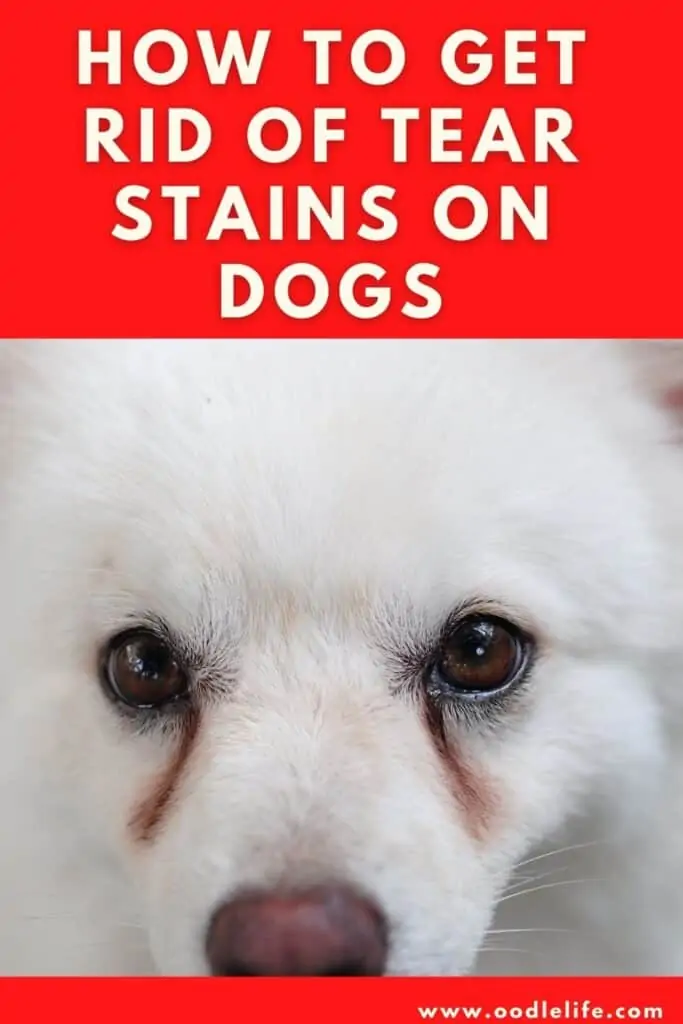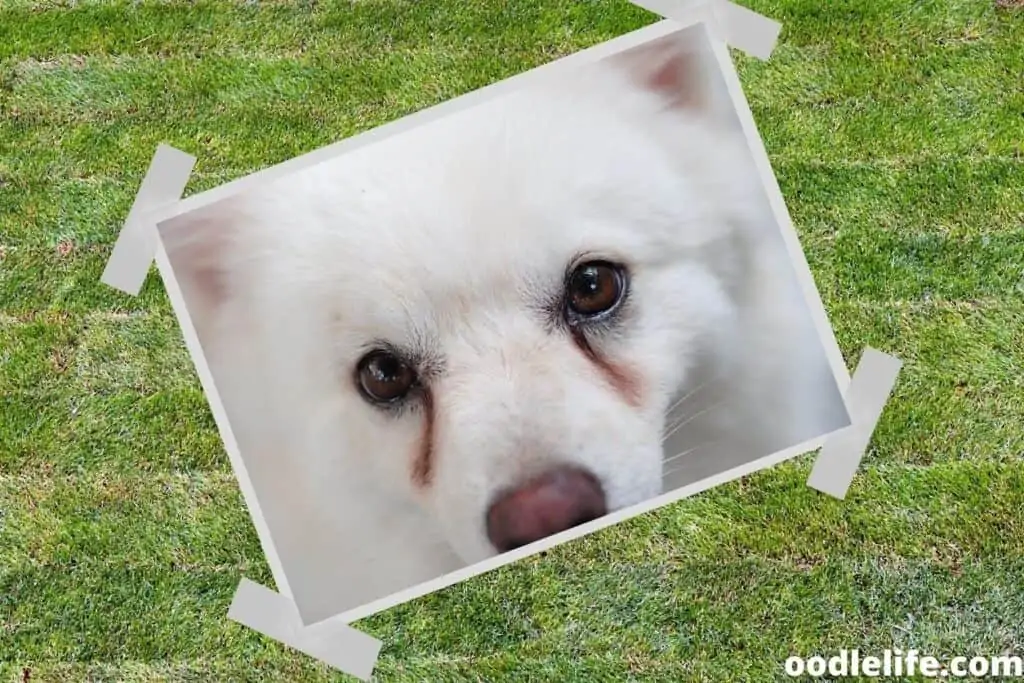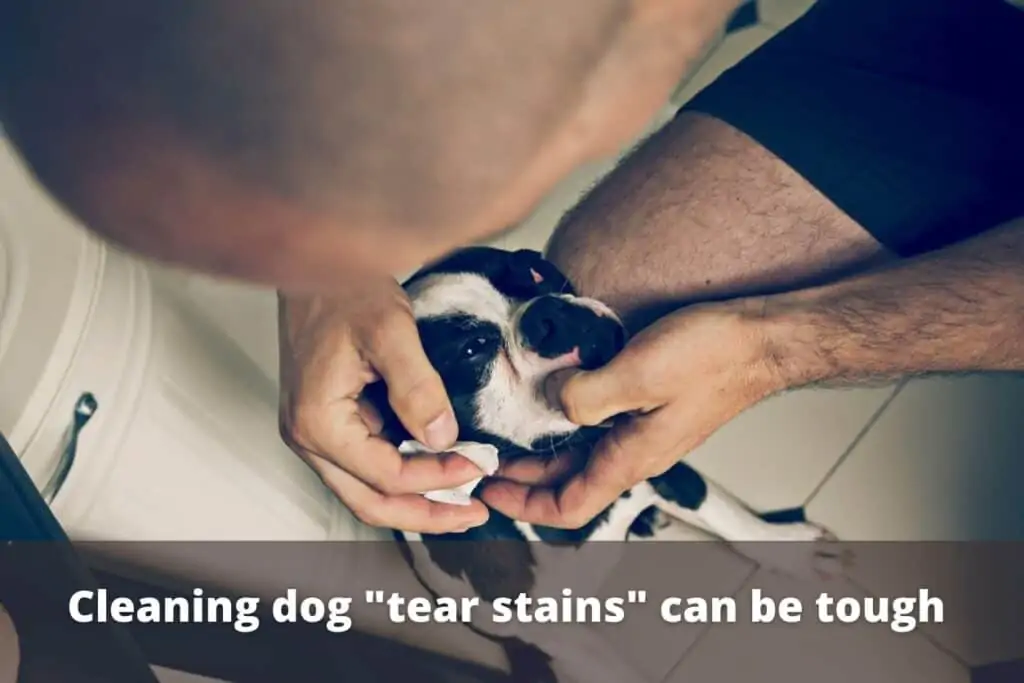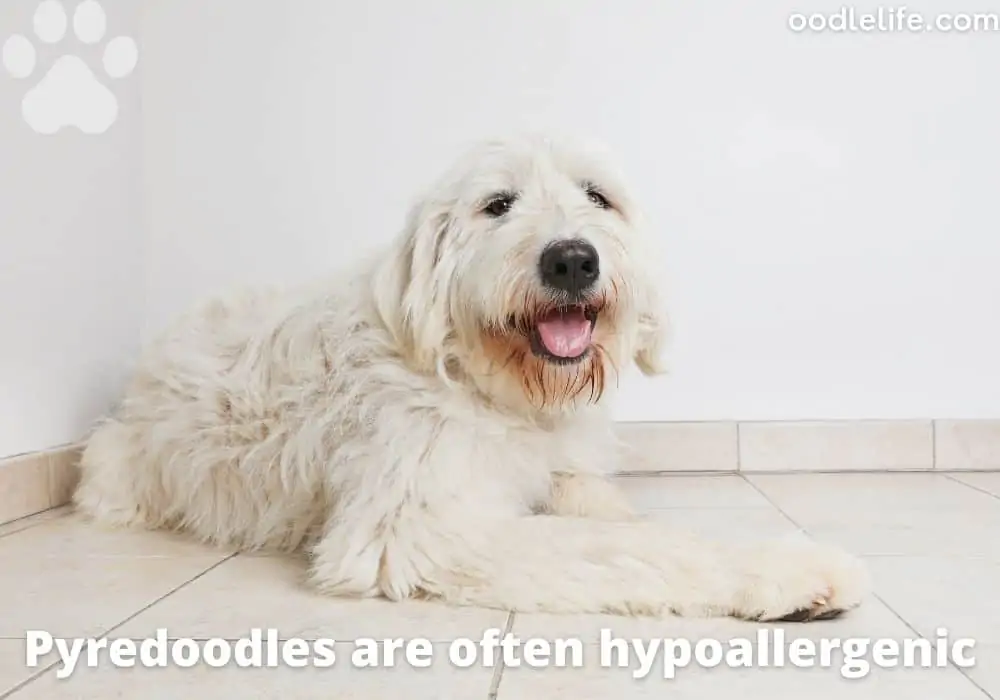How To Get Rid of Tear Stains on Dogs
Although dogs are emotional creatures, they don’t shed visible tears when crying or in pain. However, they do get runny eyes, which many people call tears.

Irritated eyes, allergies, diet, infection, and other issues can cause runny eyes in dogs.
Regardless, the watery eyes cause unsightly rusty-brown stained bits below the edges of the dog’s eyes called tear stains.
Tear stains (also known as Poodle eye or eye boogers) can be really difficult to clean and remove.
When tear stains appear, they can indicate a simple issue relating to diet and allergies or serious underlying medical conditions, especially if your dog produces excess tears.
So, is it normal for dogs to have tear stains, and how do I remove tear stains from my dog’s eyes?
What Causes Tear Stains In Dogs?

- Overgrown Fur around the Eyes. If your pet has dense hairs around their eyes, they may be suffering from irritation to the eyes. Excessive eye irritation by the fur can make your dog’s tear ducts produce excess tears. Therefore, consider trimming their hair and groom them accordingly if you suspect this is the cause.
- Allergies. If your dog has allergies, it can lead to eye irritation and thus result in the overproduction of tears.
- Ingrown Eyelash Causing Eye Irritation. Similar to dense fur, ingrown eyelashes can irritate the eyes, thereby causing overproduction of tears. If you suspect an ingrown eyelash is a culprit, use natural methods such as gently washing the area using cotton wool soaked in a solution of warm water and salt.
- Water Source and Diet. A diet with excess minerals such as iron can cause the overproduction of tears. Therefore, consider reverting to the previous diet if you have recently changed your dog’s diet and noticed tear stains weeks later.
- Infections. Eye or ear infections can cause watery eyes, and this is majorly the case if one tear stain is more apparent than the other, as it indicates an infection in one ear or eye. If you suspect your dog has an eye or ear infection, pay a visit to your vet.
- Glaucoma. Glaucoma, a painful buildup of pressure in the eye, can also be the culprit of water eyes. Some other glaucoma symptoms include dilated pupil that doesn’t constrict with light and cloudy eye appearance. Should this cause tear stains, visit the vet as soon as possible as glaucoma can cause blindness.
How to Fix Dog Tear Stains
1. Clean the Area Early and Regularly
The easiest way to fix dog tear stains is by cleaning the gunk as early as possible, before the stains sets in the fur. You can choose to buy an all-natural dog tear stain remover, which can come in liquid, paste, wipe, or powder form. It all depends on what works best for your fur friend.
To be brief, liquid removers are good if the stains have set in. The liquid softens dried eye crust, making it easier for you to wash them off from your dog’s fur. Wipes, too, help to remove gunk buildup around your dog’s eyes. Paste removers keep bacteria at bay, while powder removers keep your dog’s face dry.

2. Trim Stained Fur
Removers can lighten and even take out superficial tear stains, but if the stains are deep into the fur, the best way to fix them is to trim the fur. Trimming the fur gives room for new, unstained hair to grow in. Of course, this will take time, but if you are proactively cleaning and grooming your dog’s face, you should notice a significant improvement in the disappearance of stains.
For dogs with short hair that’s impossible to trim, follow the first tip – clean the area regularly using all-natural dog tear stain removers to keep new stains at bay and wait for the stained fur to shed naturally. Soon, with patience, new, unstained hair will grow.
3. Use Natural Remedies
If you’re a chemical-conscious dog owner, you may be wary of using removers as many pet products contain harsh chemicals that might be effective but harmful to your dog’s skin.
Fortunately, there are natural remedies you can use. Although not as fast in removing tear stains, they do work if you are persistent in using them. Here are some natural remedies you can use to remove dog tear stains:
Use Hydrogen Peroxide
Hydroxide peroxide has many uses, and now we add another use; it can help fix tear stains in dogs. However, you should be extra careful not to let it get into your dog’s eyes. Also, make sure to dilute it, as using it undiluted could dry out your dog’s skin.
You can couple it with tea tree oil and lemongrass oil to help fight bacteria on your dog’s skin and eyes.
Apple Cider Vinegar
You can also dilute apple cider vinegar in water and apply it to the stained area. As with hydrogen peroxide, you should be cautious to avoid the solution from coming into contact with the eyes. Also, make sure to use a pre-mixed solution from a reputable company.

Feed Your Dog Foods That Improve Its Gut Health
One of the causes of tear stains in dogs is diet. Dog foods with wheat and corn can cause allergic reactions, resulting in excess tearing. In other words, dry dog foods with many filler ingredients and artificial preservatives are not nutritious to the dogs and may likely cause irritations.
Therefore, make sure to feed a high-meat protein meal and supplement with probiotics as well as unsweetened yogurt. Also, animal fat in moderation is good for the gut.
How to Prevent Tear Stains In Dogs
We’ve already said that the best way to prevent dog tear stains is to wipe them early and often. Dogs often get watery eyes, and this trickles down on the edges of the eyes.
It would be best if you wiped their face often to prevent the tears from settling in. To do this, have dog eye wipes with you and ensure they do not have harmful chemicals.
In addition to regular wiping, there are other steps you can take to reduce stains appearance:
Feed Your Dog Quality Food
Overly processed dog foods with filler ingredients and artificial flavors can irritate your dog’s digestive system and increase tearing due to allergies.
Also, avoid changing your dog’s diet as this may cause allergic reactions. If a certain food tends to work for your dog, stick to it for a considerable time before trying another brand.
Also, avoid treats that claim to have supplements and enzymes that prevent tear stains. In most cases, these treats contain harsh antibiotics that can harm your dog. Unless the vet recommends the treat, exercise caution when giving it to your dog.
For yogurt and other food additives, make sure they are all-natural and unsweetened.

Give Them Filtered Water
The quality of the water your dog drinks could worsen its tearing issue. If you notice rusty-colored tear stains, the chances are that water is the culprit. Therefore, consider giving them filtered water for several weeks to see if there will be a noticeable difference.
Also, make sure to wash the water dish so it doesn’t harbor bacteria that could lead to allergies.
Trim Their Facial Hair
Trimming and grooming your dog’s facial hair can help mitigate tear stains by preventing eye irritation. Keeping the hair short also makes it easier for you to clean the tears before they settle deep into the fur.
Rinse Their Face Often
Like humans, dogs get allergies from external elements such as pollen and dust. Therefore, if you just took your dog outdoors and it passes through a pollen-field lawn, rinse their eyes to prevent an allergic reaction that may cause watery eyes. Make sure to use all-natural eye rinse for dogs.
Fixes to Avoid
Bleaching Products
Many whitening or bleaching products have harsh chemicals that could dry out your dog’s skin and cause skin irritation, while others can cause shedding of fur. Therefore, exercise caution when using whitening products.
Antibiotics
Some tear stain treats contain antibiotics that may help dry out your dog’s eyes to prevent the formation of new stains. However, antibiotics should never be misused as they can have long-lasting effects on your dog’s body. That’s why you should keep off treats or products with antibiotics unless your vet recommends it.
Conclusion
Tear stains are unavoidable if you don’t rinse your dog’s eyes and face often. Make sure to clean and groom your dog’s face regularly and feed it quality food and water.
If tear stains have settled in, there are different ways of fixing them, including trimming facial hair, using all-natural tear stain remover, or using natural remedies such as hydrogen peroxide.